Our load securing experts
How can we help you?

Do you need help on how best to transport a particular load safely? Contact our cargo securing experts - they will be happy to help.
Contact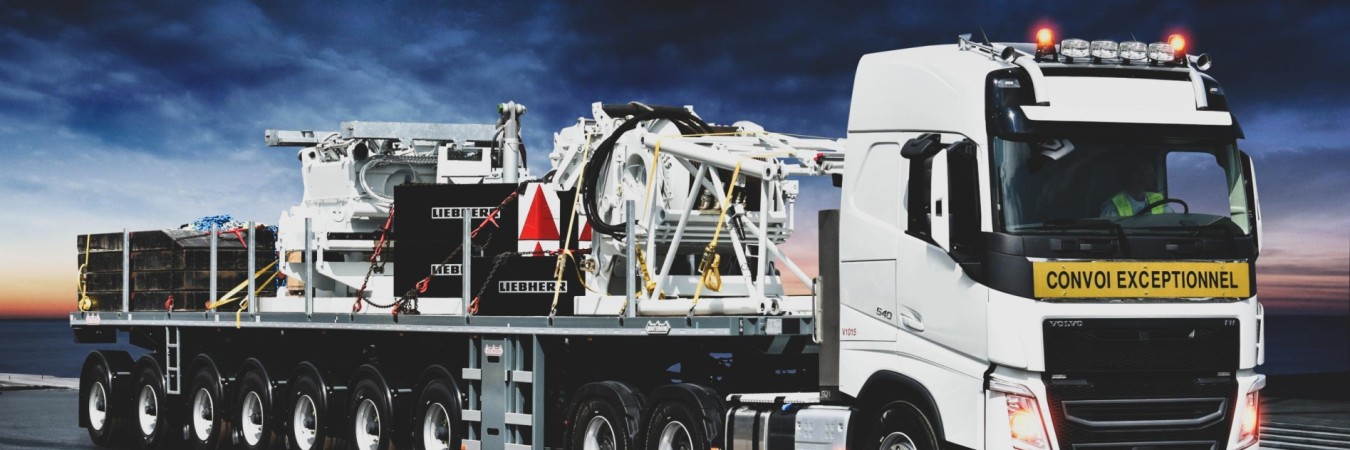
Basically, there are two ways to safely secure cargo. For example, cargo can be pressed against the bottom of a means of transport, effectively increasing friction to the point where it cannot slide. But cargo can also be secured by means of fillers, against a vertical wall or another piece of cargo, leaving no room for it to move. Thus, no force is applied here, but use is made of volume.
The terminology used varies by sector, but the principles are generally the same. In road transport, it is usually referred to as cargo securing, even though the word lashing occurs regularly here.
Anyone who is going to choose a method of securing cargo will first of all have to ask themselves in what way the cargo can move. A load that is lashed down to prevent sideways tilting or rolling, may always be able to move straight ahead or straight backwards. And cargo strapped into a container to prevent movement occur when a lorry brakes hard (movement in the horizontal plane), it may still be able to move on an ocean-going vessel, because very different forces are involved there (vertical movements).
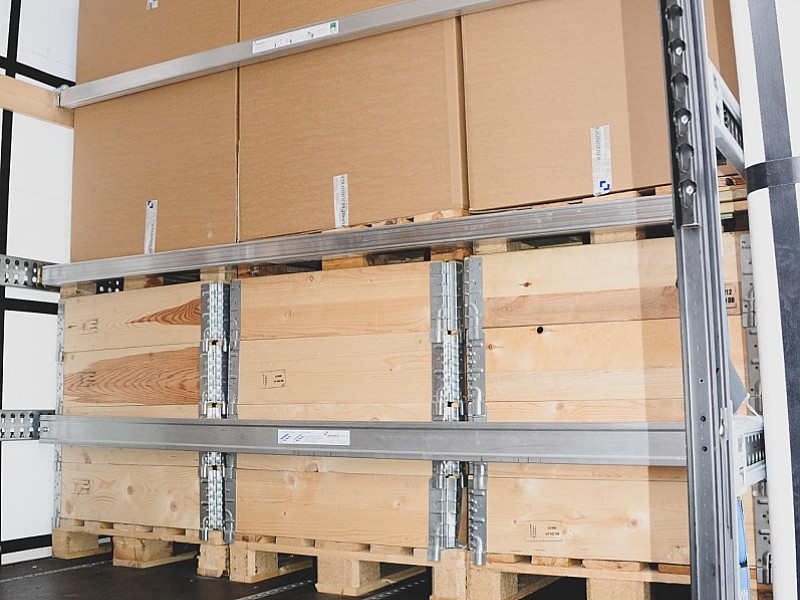
To do this, we first look at the different ways there are to secure cargo and then at the different tools that can be used in the process. Finally, we look at choosing the right method for the various modes of transport. These are general ways of securing cargo.
Force closure
When goods are secured with, for example, straps against the bottom of a container, it can be referred to as force locking. By lashing the goods down, the friction is in fact made so great that they cannot shift.
Lashing tie-down
The cargo is pressed against the supporting surface by means of lashing straps, for example, so that the friction becomes so high that sliding is no longer possible. The bottom corner should be kept as wide as possible, preferably almost against the load. The lashing straps or tensioning chains are tightened as firmly as possible. How well they should be lashed down and with what material can be calculated fairly precisely. The choice of lashing material can be adjusted accordingly.
Form closure
Another option for securing goods is to use pieces of wood or air bags, for example. This is called form-fastening. The materials used to secure the goods must be strong enough to absorb the forces created during transport.
Lashing straps
It is important to choose the right lashing strap for a particular load. There is an enormous choice of lashing straps for all kinds of purposes. We can advise you on this without any obligation. It is also important to apply the lashing strap correctly so that the load is actually secured.
The usual European standard for lashing straps is EN 12195-2.
There are different types of lashing straps and each type is subdivided into types, depending on the choice of material and the desired length, width and strength: The lashing strap with clip buckle is basically the simplest lashing strap. It consists of a strap that is placed around the object to be secured and fastened with a simple clamp. Tightening is done by hand. This type is intended for holding cargo together, but not for lashing cargo to a load carrier. The ratchet strap with pointed hooks consists of two parts and is intended for lashing cargo to a load carrier, e.g. a trailer with lashing eyes.
A very wide variety of lashing straps is available. For instance, we offer different ratchets, hooks in different lengths and widths. Lashing straps with a hook and an eye can be fastened around the load or to each other. Some chassis are equipped with a so-called windlass. Lashing straps can be attached to these without hooks or eyes.
The use of lashing straps is subject to strict requirements. Wear and tear is absolutely out of the question.
Stitching in danger of wearing out can be repaired at our premises if necessary. If the material of the lashing strap itself wears out, it must be disposed of immediately. This also applies to straps with cuts or tears. Even the smallest nick reduces the load capacity of the lashing strap very much and therefore cannot be tolerated.
Lashing straps can damage the corners of cargo units due to the tension placed on them. There are protective corners on the market, which help to prevent this shortcoming. For lighter loads, these may be corners made of cardboard or plastic; for heavier loads, they may be metal corner elements.
Lashing straps are made of plastic. The most commonly used fabrics are:
* Polyester - this material loses some of its strength when wet, is very resistant to medium-strength acid, but can be damaged by bases. The material is not very stretchy, allowing the strap to maintain tension during transport. All straps we offer are made of polyester.
* Polyamide - can lose up to 15 per cent of its strength when wet. It resists bases well, but can be damaged by acids of medium strength.
* Polypropylene - this fabric is resistant to the influence of chemicals and has a very high stretch.
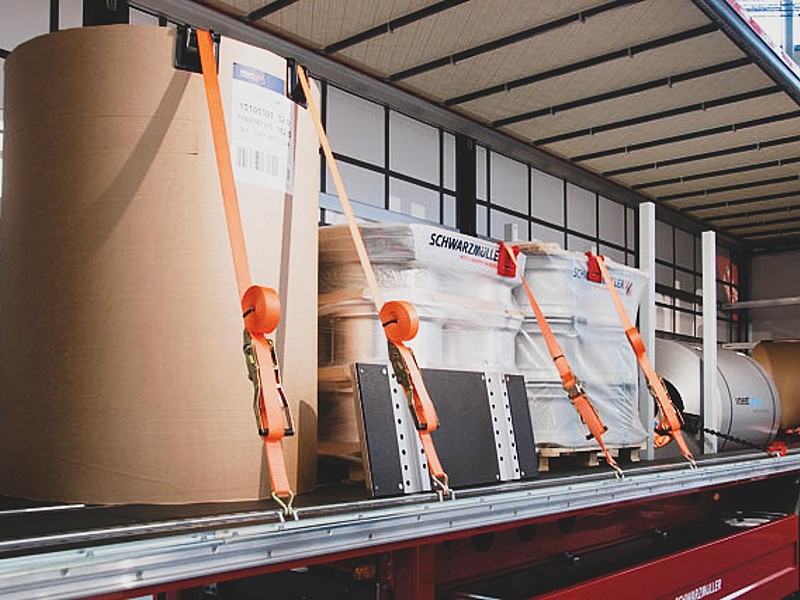
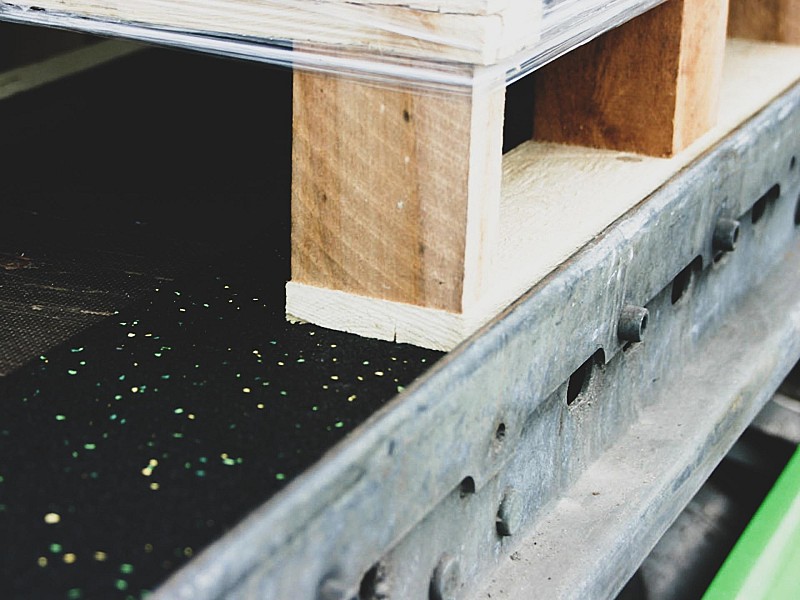
Friction materials and friction paper
Anti-slip mats (also known as friction mats) serve to increase the friction between the load unit and the load carrier to such an extent that the load is prevented from sliding or slipping. Anti-slip mats can be supplied as sheets or rolls. In the latter case, they can be rolled out and cut to size and available in various thicknesses. Although the mats can be used more often, wear and tear can cause a decrease in friction.
Usually, anti-slip mats are made of high-friction material such as rubber granulate. The thickness itself does not affect friction, but the weight of the load placed on the mats must not cause more than 30 per cent deformation (compression) of the material thickness of the mat, according to this standard. A label attached to the mat indicates the material the mat is made of and the maximum load per square metre.
Thin anti-slip mats can also be used to ensure that stacked boxes do not slide off each other or that boxes do not slide off a pallet.
Anti-slip material should be handled with care. When such mats or sheets are on the loading floor and a forklift drives over them, the material loses a significant part of its resistance. The same happens when dirt or grease gets on it. However effective the mat is, optimum performance is only achieved when the floor on which the mat or sheet rests and the load on it are clean, dry and grease-free.
Lashing or tensioning chains
Lashing chains are still used for securing heavier cargo, for example on the deck of a ship, on a pontoon or a flat car such as a roller trailer or terminal tractor. Chains are made of various types of steel, each of which has its own maximum load capacity. The chain should be labelled with the specifications as given by the manufacturer. Not only the diameter of the links can vary, making one chain thicker or thinner than another, but also the length of the individual links.
One disadvantage of chains is that they are expensive. Therefore, lashing chains are usually used only when it is certain that they will be returned to the owner. They can be a permanent part of the equipment present on, for example, a pontoon. An advantage of chains is that they are strong. Chains are tensioned with a so-called lever tensioner.
Tensioning chains are subject to wear and tear and soon need to be replaced.
The requirements for tensioning chains are specified in European standard EN 12195-3.
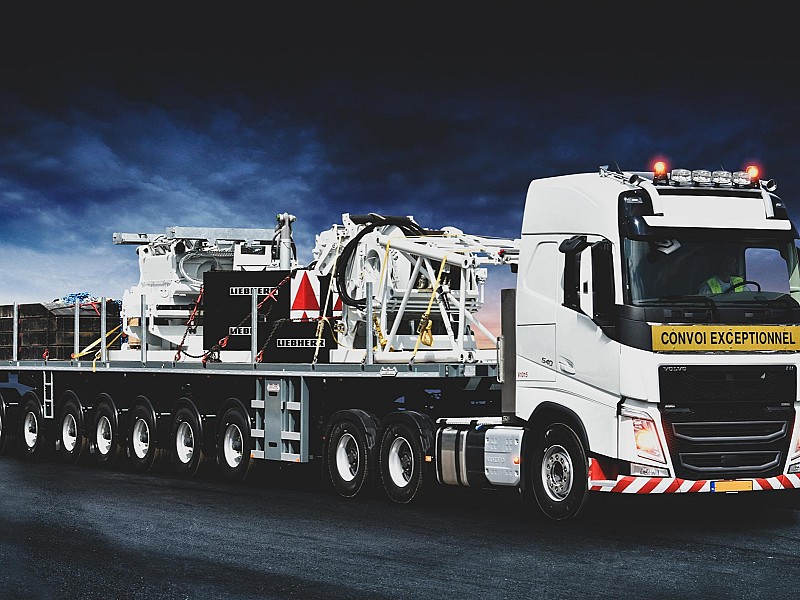
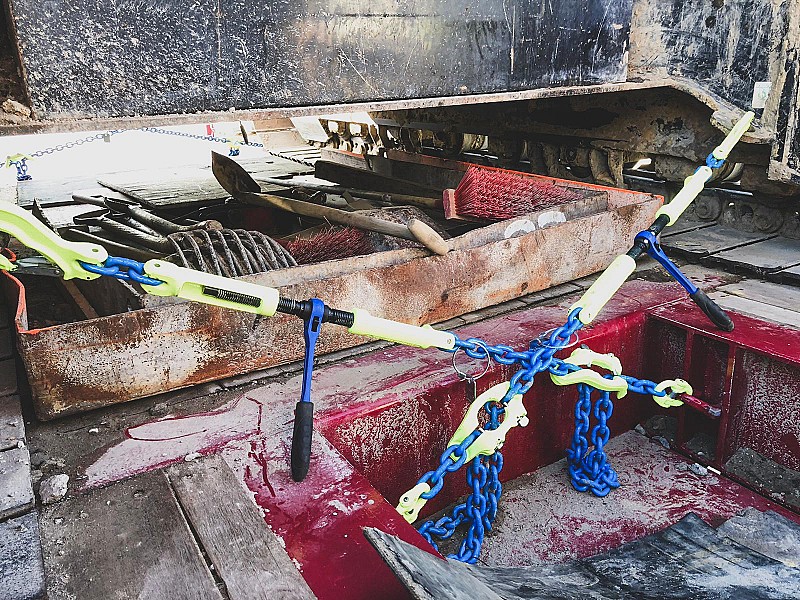
Ratchet tensioners
Tensioning chains, tensioning cables and tensioning belts that are used several times can be tensioned with ratchet tensioners. When used to tension a chain, they are equipped with eyes and hooks.
The ratchet tensioners for tensioning cables have steel cable handles. By keeping the handle short, overloading the chain can be prevented. As with ratchets for tensioning straps, the standard is predominantly that no more than 50 daN manual force should be applied. The ratchet is designed accordingly.
Tension force indicators
When lashing down, the friction between load and load floor should be made as high as possible. The lashing straps or tensioning chains are then tightened extra strongly. By using ratchet tensioners with a high preload force (STF), the number of straps needed can be reduced, as long as the permitted values are not exceeded. The preload can be measured with a tension gauge attached to the strap.
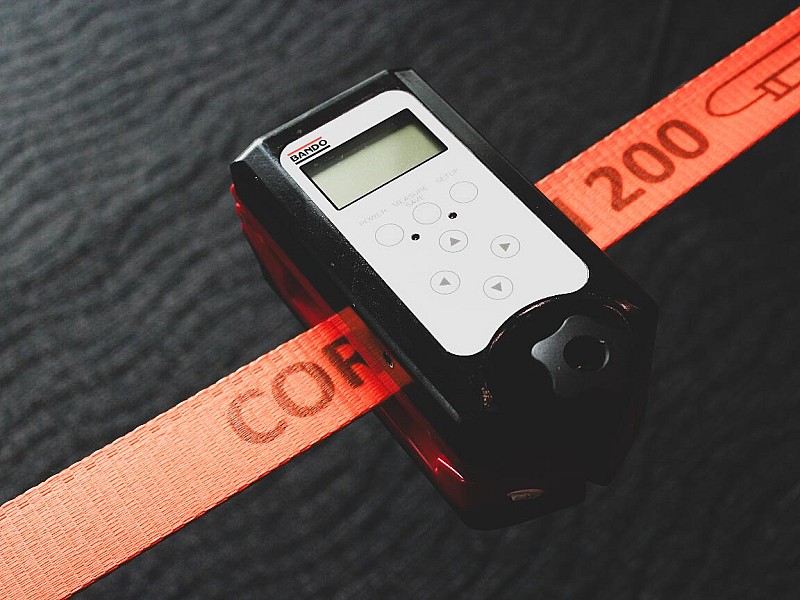
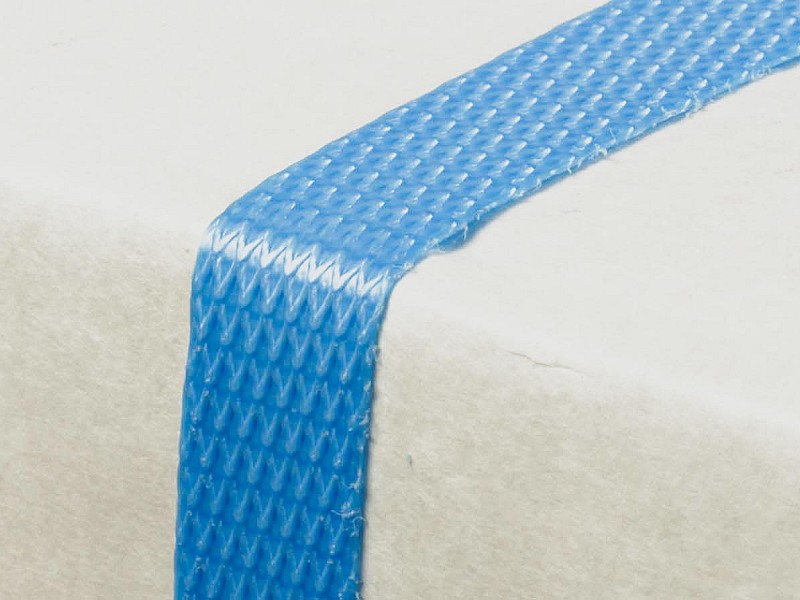
Strapping
Cargo can be held together by means of strapping. Steel strap was often used for this purpose. This had the disadvantage that due to its rigidity it was not able to absorb shocks well and, moreover, steel straps can be dangerous to use, as they are very sharp and can come loose when cut.
Strapping made of polypropylene or polyester does not have these disadvantages or much less. Moreover, these straps can be loosened by hand if they are applied correctly, namely by leaving a piece of strap free after the bonding point. The breaking strength then depends on the type of material used, its width and thickness and on the bonding.
Various types of strapping can be distinguished:
Load securing tape (Ty-Gard)
Ty-Gard® and Road-Gard® are registered brand names of a system consisting of wide tape made of super fibre, which is anchored to the inner walls of containers and trailers by means of an adhesive part with high bonding capacity. Extensive tests in the United States and Europe have shown that Ty-Gard (for containers) and Road-Gard (for trailers) are capable of adequately securing cargo longitudinally, eliminating the need for anti-slip mats and diagonal lashings in trailers.
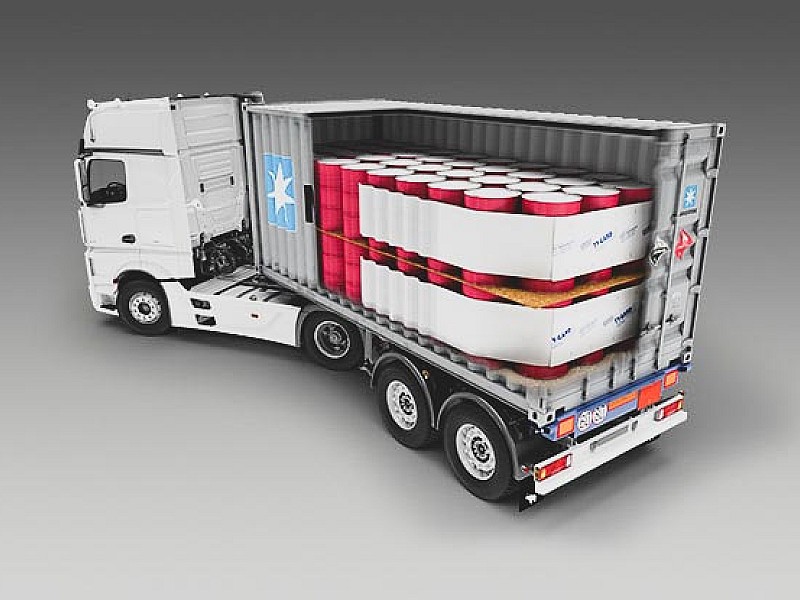

Foil
A common solution for bundling quantities of cargo, especially on pallets, without the risk of local damage due to steel or lashing strap cuts, is the use of foil. The main advantage of this is that the tension is distributed over the entire surface of the load and therefore does not press or cut into a single spot. Moreover, film can be easily applied. In particular, wrapping film, which can be applied manually or with a wrapping machine around a loaded pallet, is very popular.
The two main film types for load securing are Shrink film and Stretch film:
Shrink film
Shrink film is a transparent plastic that is tightly stretched around the material to be packed by heating. The shrink film is first placed over the material, such as a loaded pallet, so that it completely envelops the goods. The film is then heated, for example by means of gas burners. Heat guns are also used for larger packages. The film shrinks due to the heat and then cools down. This makes for very sturdy packaging, partly because the plastic may harden slightly due to the heating and subsequent shrinking.
A major drawback, however, is the use of open flame. This poses a risk not only to the load, but also to the environment and people working with these tools. Finally, there is also the environmental impact of burning.
Stretch film
No heating is required when using stretch film. However, it is very important to pay attention to the right specifications. When applied manually, there is a tendency to wrap too few or too many layers around the material. Machines for stretch film application have the advantage that the type of film, quantity and tension can be correctly calculated in advance. The machine then provides standardised winding.
Each type of film has its own properties, such as the material used, thickness and width. Dependent on this, in turn, is the strength. By using film, great shape retention can be achieved. A properly wrapped pallet passes the 26-degree test.
Nets and tarpaulins
Before film came into general use, pallets were mostly secured with nets. In air cargo, nets are still often used. However, nets have the same disadvantages as rope. It is difficult to give nets the right tension, they can cause cargo damage and may also become damaged themselves. When choosing the right net, attention should be paid to the thickness of the cord and the size of the meshes. Before fitting, the net should be checked for any damage.
Tarpaulins also lend themselves to shape-stabilising cargo, for example, on pallets or groups of pallets after securing them individually by placing the tarpaulins over the cargo and tensioning them with rope. The advantage of a tarpaulin, as with foil, is the distribution of force, which greatly reduces the risk of damaging the load. This is especially important when transporting bales and plastic drums. The tarpaulin can be tensioned with straps.
Nets and tarpaulins can also serve to cover cargo, such as scrap iron and construction waste. They prevent junk from falling off the wagon. With bulk goods such as sand and gravel, it is important to prevent scattering. With gravel in particular, loss can lead to serious damage to other vehicles.
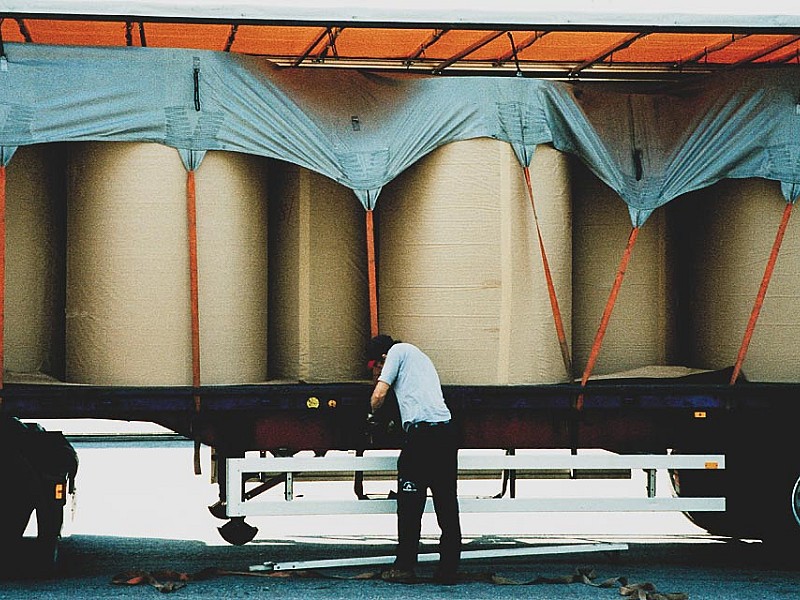
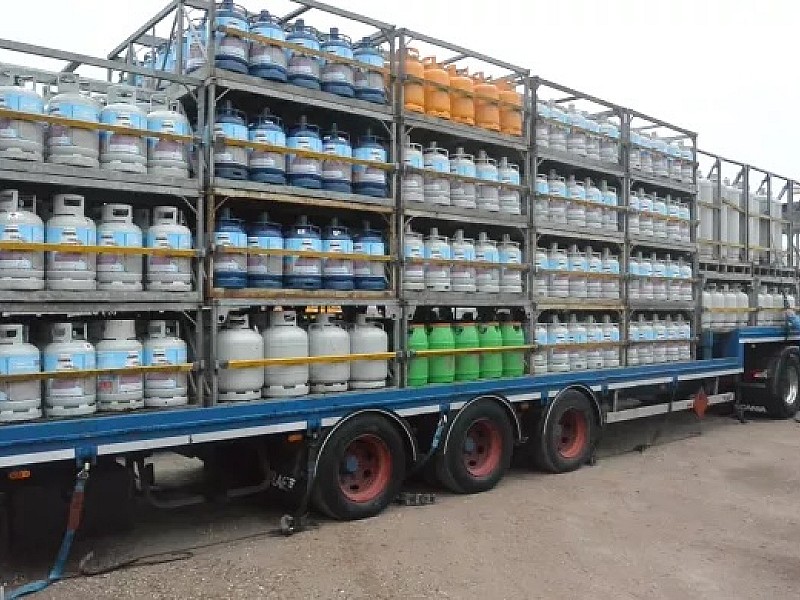
Loading boxes
For the transport of loose materials such as pipes and, for example, metal beams and for gas cylinders, cargo boxes are on the market, which can be used to divide the load into individual units. These can then be secured as dimensionally stable units.
Gas cylinders are often tied to such a cargo box with straps to prevent them from moving.
Forms and fillers
A very effective way of securing cargo is to fill the spaces between goods. This can only be done when the walls of the cargo are strong enough. Further securing is then unnecessary. The walls of containers are generally strong enough to absorb forces in the horizontal plane. The side walls of a trailer are generally not, but the reinforced XL trailer is able to withstand front, side and rear forces during transport to a limited extent.
Dunnage bags can be filled with air. They are then tensioned with compressed air equipment. High loads are possible here, sometimes up to 40 tonnes. However, it is then necessary to follow the manufacturer's instructions very precisely.
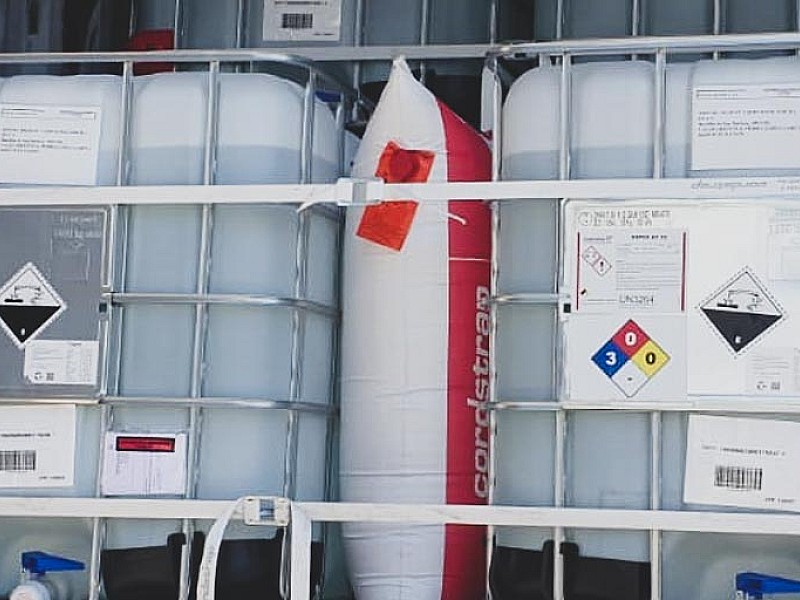
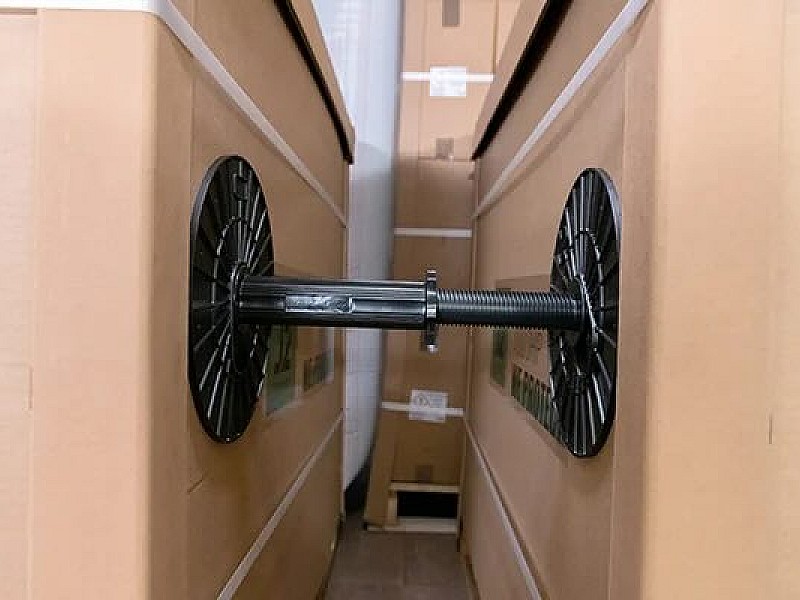
Void-Gard
The Void-Gard® is an adjustable load stamp made of plastic, which can absorb very high forces without the risk of collapse, as with dunnage pads. They are easy to apply to fill free spaces of several decimetres. A prerequisite is that the cargo is packed tightly enough to absorb the pressure of the discs, which are about a 30 cm in diameter.
The Void-Gard must also be placed against a reasonably flat surface. This can possibly be done with attachments such as a flat sheet of cardboard or plywood.
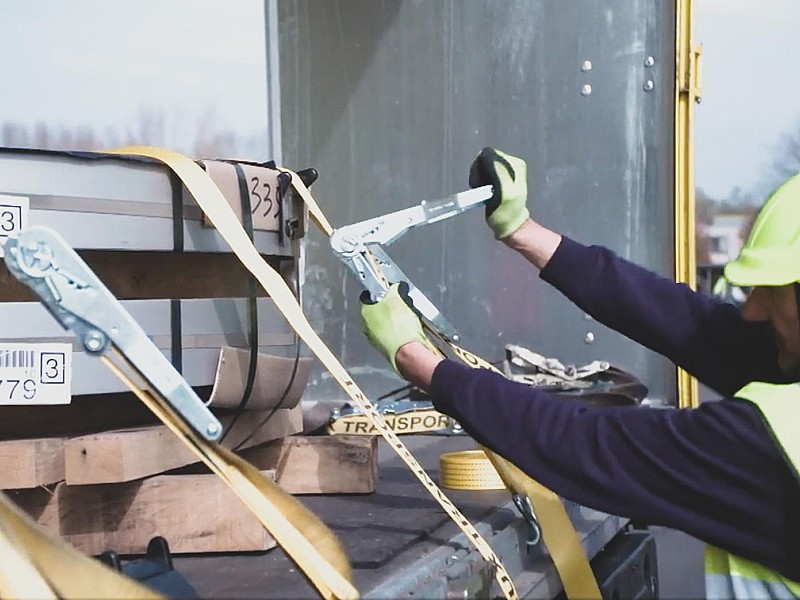
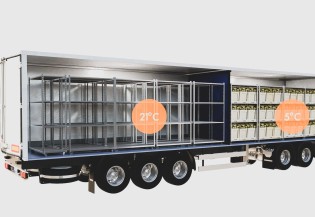
Find every download related to IsoLok: User Manuals, Mounting Instructions, Product Information and Brochure.
Read more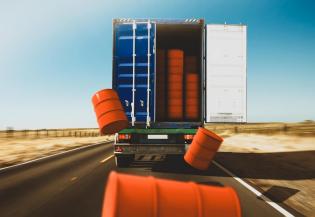
As a transport company, you know that ensuring the safety of your cargo is evident —not just for operational efficiency but also to comply with regulations.
Read more